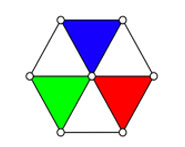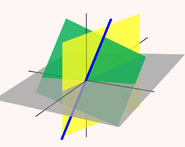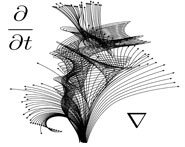


 تاريخ الرياضيات
تاريخ الرياضيات
 الرياضيات في الحضارات المختلفة
الرياضيات في الحضارات المختلفة 
 الرياضيات المتقطعة
الرياضيات المتقطعة
 الجبر
الجبر
 الهندسة
الهندسة 
 المعادلات التفاضلية و التكاملية
المعادلات التفاضلية و التكاملية 
 التحليل
التحليل
 علماء الرياضيات
علماء الرياضيات | Covering Maps and Discontinuous Group Actions-Isomorphisms of Covering Maps |
|
|
|
Read More
Date: 25-7-2021
Date: 12-6-2021
Date: 17-6-2021
|
Definition Let p1: X˜1 → X and p2: X˜2 → X be covering maps over some topological space X. We say that the covering maps p1: X˜1 → X and p2: X˜2 → X are topologically isomorphic if there exists a homeomorphism h: X˜1 → X˜2 from the covering space X˜1 to the covering space X˜2 with the property that p1 = p2 ◦ h.
We can apply Theorem 1.19 in order to derive a criterion for determining whether or not two covering maps over some connected locally path connected topological space are isomorphic.
Theorem 1.21 Let X be a topological space which is both connected and locally path-connected, let X˜1 and X˜2 be connected topological spaces, and let p1: X˜1 → X and p2: X˜2 → X be covering maps over X. Let w1 and w2 be points of X˜1 and X˜2 respectively for which p1(w1) = p2(w2). Then there exists a homeomorphism h: X˜1 → X˜2 from the covering space X˜1 to the covering space X˜2 satisfying p2 ◦ h = p1 and h(w1) = w2 if and only if the subgroups p1#(π1(X˜1, w1)) and p2#(π1(X˜2, w2)) of π1(X, p1(w1)) coincide.
Proof Suppose that there exists a homeomorphism h: X˜1 → X˜2 from the covering space X˜1 to the covering space X˜2 for which p2 ◦h = p1 and h(w1) = w2. Thenh#(π1(X˜1, w1)) = π1(X˜2, w2), and therefore
p1#(π1(X˜1, w1)) = p2# (h#(π1(X˜1, w1))) = p2#(π1(X˜2, w2)).
Conversely suppose that p1#(π1(X˜1, w1)) = p2#(π1(X˜2, w2)). It follows from Proposition 1.16 that the covering spaces X˜1 and X˜2 are both locally path-connected, since X is a locally path-connected topological space. But X˜1 and X˜2 are also connected. It follows from Theorem 1.19 that there exist unique continuous maps h: X˜1 → X˜2 and k: X˜2 → X˜1 for which p2 ◦ h = p1, p1 ◦ k = p2, h(w1) = w2 and k(w2) = w1. But then p1 ◦ k ◦ h = p1 and (k ◦ h)(w1) = w1. It follows from this that the composition map k ◦ h is the identity map of X˜1 (since a straightforward application of Theorem 1.19 shows that any continuous map j: X˜1 → X˜1 which satisfies p1 ◦ j = p1 and j(w1) = w1 must be the identity map of X˜1). Similarly the composition map h◦k is the identity map of X˜2. Thus h: X˜1 → X˜2 is a homeomorphism whose inverse is k. Moreover p2 ◦ h = p2. Thus h: X˜1 → X˜2 is a homeomorphism with the required properties.
Corollary 1.22 Let X be a topological space which is both connected and locally path-connected, let X˜1 and X˜2 be connected topological spaces, and let p1: X˜1 → X and p2: X˜2 → X be covering maps over X. Let w1 and w2 be points of X˜1 and X˜2 respectively for which p1(w1) = p2(w2). Then the covering maps p1: X˜1 → X and p2: X˜2 → X are topologically isomorphic if and only if the subgroups p1#(π1(X˜1, w1)) and p2#(π1(X˜2, w2)) of π1(X, p1(w1)) are conjugate.
Proof Suppose that the covering maps p1: X˜1 → X and p2: X˜2 → X are topologically isomorphic. Let h: X˜1 → X˜2 be a homeomorphism for which p2 ◦ h = p1. Then p1#(π1(X˜1, w1)) = p2#(π1(X˜2, h(w1))).
It follows immediately from Lemma 1.7 that the subgroups p1#(π1(X˜1, w1)) and p2#(π1(X˜2, w2)) of π1(X, p1(w1)) are conjugate.
Conversely, suppose that the subgroups
p1#(π1(X˜1, w1)) and p2#(π1(X˜2, w2))
of π1(X, p1(w1)) are conjugate. The covering space X˜2 is both locally path connected (Proposition 1.16) and connected, and is therefore path-connected (Corollary 1.17). It follows from Lemma 4.7 that there exists a point w of X˜2 for which p2(w) = p2(w2) = p1(w1) and
p2#(π1(X˜2, w)) = p1#(π1(X˜1, w1)).
Theorem 1.21 now ensures that there exists a homeomorphism h: X˜1 → X˜2 from X˜1 to X˜2 such that p2 ◦ h = p1 and h(w1) = w. It follows that the covering maps are topologically isomorphic, as required.



|
|
|
|
دخلت غرفة فنسيت ماذا تريد من داخلها.. خبير يفسر الحالة
|
|
|
|
|
|
|
ثورة طبية.. ابتكار أصغر جهاز لتنظيم ضربات القلب في العالم
|
|
|
|
|
|
|
سماحة السيد الصافي يؤكد ضرورة تعريف المجتمعات بأهمية مبادئ أهل البيت (عليهم السلام) في إيجاد حلول للمشاكل الاجتماعية
|
|
|